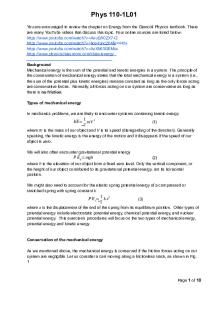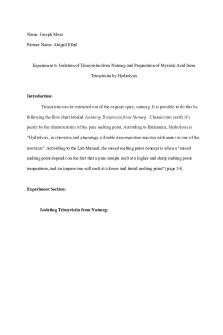PHY2048L Lab Report 5 PDF

| Title | PHY2048L Lab Report 5 |
|---|---|
| Author | Lynda Vann |
| Course | Physics with Calculus 1 Lab |
| Institution | Miami Dade College |
| Pages | 2 |
| File Size | 73 KB |
| File Type | |
| Total Downloads | 54 |
| Total Views | 149 |
Summary
Lab Report for Concurrent Forces to use as an example. ...
Description
Lynda Vann 02-13-2020 Lab partners: Dayana Evora, Chloe Ibanez, Estefany Moreno, Annabel Tello PHY2048L Prof. Miguel Faxas Equilibrium of Concurrent Forces I. II.
Purpose: To study the equilibrium of a body under the action of concurrent forces and verify Newton's First Law. Method: 1. Set up the force table with two pulleys and two equal weights from the hook. 2. Move the pulleys until the ring is set in the center of the force table. 3. Measure the angle of each cord. 4. Find the force for the x and y component. 5. Add one more pulley(now you have three) and hang three different weights from the hooks. 6. Move the pulleys until setting the ring in the center of the force table. 7. Measure the angle for each cord(which corresponds to the force due to the weights hanging). 8. Find for this force the x and y component. 9. Add one more pulley(now having 4) and hang four different weights from the hooks. 10. Move the pulleys until the ring is set in the center of the force table. 11. Measure angle for each cord. 12. Find x(Fx) and y(Fy) components for the force. 13. Verify equilibrium condition for translational motion.
F1 R
F 2 F3
III.
Results: See data table.
IV.
Conclusion: The purpose of this lab is to verify Newton’s First Law and study the equilibrium of a body. Some errors we observed were using the same weight for the hooks since it would cause them to cancel out and not having the same equal weight for the hooks in the first trial. We reduced the amount of error by using different amounts of weights for each hook across from each other to make the angle not be either 0 degrees or 270 degrees. This experiment confirmed the objectives because in order to find the sin and cos angle of the weights, pythagorean theorem had to be used and we had to add vectors. It was important that the strings were in the center of the table to show the difference of the weights at rest versus at a different angle. The measurements calculated from the data table satisfied the requirements Newton’s First Law because when the weights were equal, the angle was zero degrees. However, when there were three different weights, there were very similar in sin and cos angles. Also, when subtracting the Fx components and Fy components, the numbers varied slightly as well. The points still passed through the same point, according to the data table....
Similar Free PDFs

PHY2048L Lab Report 5
- 2 Pages

LAB 5 - Lab report
- 4 Pages

Lab Report 5 - lab
- 5 Pages

Lab 5 - Lab report
- 6 Pages

Lab 5 - Lab experiment report
- 6 Pages

Lab 5 Lab Report- (Microbiology)
- 4 Pages

Phys lab 5 - Lab report
- 10 Pages

Experiment 5 - Lab Report 5
- 16 Pages

Post Lab Report Lab 5
- 5 Pages

Lab Manual PHY2048L for current 2021
- 71 Pages

Lab 5 Report
- 5 Pages

Chem lab report 5
- 7 Pages

Lab 5 Report
- 8 Pages

EX 5 lab report
- 10 Pages

Lab Report 5
- 8 Pages

Lab Report 5
- 16 Pages
Popular Institutions
- Tinajero National High School - Annex
- Politeknik Caltex Riau
- Yokohama City University
- SGT University
- University of Al-Qadisiyah
- Divine Word College of Vigan
- Techniek College Rotterdam
- Universidade de Santiago
- Universiti Teknologi MARA Cawangan Johor Kampus Pasir Gudang
- Poltekkes Kemenkes Yogyakarta
- Baguio City National High School
- Colegio san marcos
- preparatoria uno
- Centro de Bachillerato Tecnológico Industrial y de Servicios No. 107
- Dalian Maritime University
- Quang Trung Secondary School
- Colegio Tecnológico en Informática
- Corporación Regional de Educación Superior
- Grupo CEDVA
- Dar Al Uloom University
- Centro de Estudios Preuniversitarios de la Universidad Nacional de Ingeniería
- 上智大学
- Aakash International School, Nuna Majara
- San Felipe Neri Catholic School
- Kang Chiao International School - New Taipei City
- Misamis Occidental National High School
- Institución Educativa Escuela Normal Juan Ladrilleros
- Kolehiyo ng Pantukan
- Batanes State College
- Instituto Continental
- Sekolah Menengah Kejuruan Kesehatan Kaltara (Tarakan)
- Colegio de La Inmaculada Concepcion - Cebu